QuSecure Honored as Global Product Leader in Post-Quantum Cryptography by Frost and Sullivan
Keeping up with the US government’s actions related to quantum computing can be challenging due to the rapid pace of advancements. The timeline below is a guiding tool for those looking to see what major events have led to the US government’s positioning to secure against the quantum threat to date.

The enables quantum computers to factor large integers exponentially faster than traditional computers. This algorithm theoretically gives quantum computers the ability break many common encryption algorithms.
In 2015 the NSA announced a plan to transition NSS to a new quantum-resilient cipher suite. Though quantum computers were still in their embryonic state at the time, the NSA explained that the threat of quantum computing was the primary consideration in the decision to withdraw the previous cipher suite, called Suite B, and prepare for the post-quantum era. The NSA stated in their announcement, “Unfortunately, the growth of elliptic curve use has bumped up against the fact of continued progress in the research on quantum computing, necessitating a re-evaluation of our cryptographic strategy.” The announcement also notes that the goal for the agency is to “provide cost-effective security against a potential quantum computer.”
This announcement was the first time that the NSA publicly recognized that quantum computing posed a serious threat to encryption, and more importantly, that it was time to act. For those watching the global forces at play, this call to action is best categorized as reactive. With a recognition that foreign states were quickly and very intentionally pushing quantum computing advancements, the US government called for action.
It’s important to note that the NSA seeks a cost-effective solution. This will undoubtably be a key obstacle for organizations across the government and private sectors during the transition to Post-Quantum Cryptography (PQC). For a solution to be cost-effective it must be compatible with existing systems; replacing hardware presents significant challenges and expenses. The NSA has deferred to the National Institute of Standards Technology (NIST) to research PQC solutions and finalize a set of quantum-resilient algorithms for use in NSS. The cost-effectiveness of this approach will largely depend on each organization’s ability to implement the new algorithms with minimal disruption to existing systems.

The 2018 National Quantum Initiative Act (NQI) funds opened for initiatives focused on advancing quantum technologies with emphasis on quantum computing.
At this point the varying types of quantum technologies began to distinguish themselves. We observed three lanes form:
Our solution, QuProtectTM is a Post Quantum Cryptography solution with backwards compatibility that falls within the category of Quantum Communication.
In 2018 the Quantum Economic Development Consortium formed as a US based collaboration of academia, government, and industry stakeholders. Publicly available thought leadership around quantum information science and technology began to increase as a result.
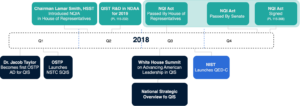
As a direct result of the 2018 National Quantum Initiative Act (NQI) the Quantum Information Science (QIS) R&D reported a budget of $450 million for the fiscal year for 2019.
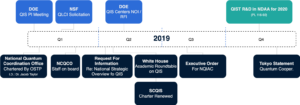
While the. NQI was signed into law in 2018 momentum was not truly gained until 2020. Several federal agencies including the National Science Foundation and Department of Energy established new quantum research centers within the US.
As a direct result of the 2018 National Quantum Initiative Act (NQI) the Quantum Information Science (QIS) R&D reported a budget of $672 million for the fiscal year 2020.
In August of 2020 a public announcement was made that Oak Ridge National Laboratory was selected by the Department of Energy to lead an effort to develop quantum computing technologies. With the NQI Act passing in 2018 the budget for the establishment of a Quantum Science Center was made available and publicized as $115 million.
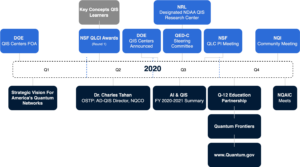
DISA, in partnership with NIST, releases a roadmap to help organizations prepare themselves for the transition to PQC.
In 2021, the NQI Annual Report indicated a “significant ramp-up” and recognized NIST, SNF, DOE, DOD, IC, and NASA as key sources of funding.
As a direct result of the 2018 National Quantum Initiative Act (NQI) the Quantum Information Science (QIS) R&D reported a budget of $855 million for the fiscal year 2021.
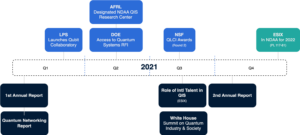
White House Memo NSM-8 mandates that those maintaining National Security Systems to prepare a transition plan for PQC.
NSM-10 mandates that all Federal agencies begin preparing for the transition to PQC.
NIST completes the third round of the PQC standardization and announces 4 algorithms to be recommended for standardization including CRYSTALS-KYBER for public key encryption.
CHIPS and Science Act (Formerly the Endless Frontiers Act) became law. This law puts billions of dollars behind maturing semiconductor technologies as well as quantum information science.
President Biden signed into law H.R.7535, the Quantum Computing Cybersecurity Preparedness Act, which encourages ‘federal government agencies to adopt technology that will protect against quantum computing attacks.
It is not until 2022 that funding for quantum truly picked up steam within the US federal budgets for QIS R&D, roughly doubling since 2019.
As a direct result of the 2018 National Quantum Initiative Act (NQI) the Quantum Information Science (QIS) R&D reported a budget of $918 million for the fiscal year for 2022, the largest budget of any office taking advantage of the NQI.
The White House published the National Institute of Standards and Technology allocation of $975 million for scientific research focusing on AI, quantum science, and cybersecurity.
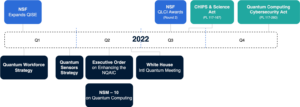
This summer the Committe on Science, Space, and Technology held a hearing to evaluate the state and progress of the NQI.
The Foundation for Defense of Democracies reported on the hearing noting, “Without a reauthorization of the NQI Act, the United States risks falling behind. As the committee itself outlined, China made clear back in 2016 its intention to overtake the United States in this field by 2030. Beijing announced two years ago that it would invest $15.3 billion into quantum R&D, double that of all other governments combined.”
The committee also reported that cryptography was a key area of concern considering the recent progressions to Quantum computing. “…it is believed that every bit of electronic information, from credit card transactions to national security secrets, could be decrypted instantly. Conversely, quantum-encrypted communications could be 100 percent secure for the near future.”
To learn about how you can leverage quantum-grade encryption for quantum-resilient protection to your communications with QuProtectTM schedule a call with our team to see how easy it is to get started.
Sources include, but not limited to: Quantum Computing Cybersecurity Preparedness Act, National Quantum Initiative Supplement to the President’s FY 2023 Budget, Oak Ridge National Laboratories News, and the Committee on Science, Space, and Technology Committee Report.